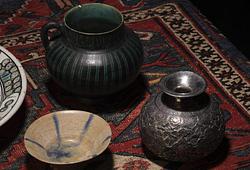Weegee (Arthur Fellig)
'Man Killed in Accident, Market Place, New York City', circa 1938-1942
Stamp 'ARTHUR FELLIG / 5 CENTER MARKET PLACE / NEW YORK CITY' verso. Also marked 042065209 in pencil verso. Gelatin silver print mounted on cardboard, image 34 x 27 cm. Mounting 34.7 x 27.5 cm.
Provenance
Stockholms Auktionsverk, Nutida, November 2012.
More information
The Whitney Museum of American Art has a very similar image, taken at the same event, in its collection. They describe the motif as follows:
'While the subject of this brutally candid photograph is, in part, a corpse being shrouded in newspapers by a pair of policemen, Weegee was always equally interested in the activity on the periphery of the turmoil, as is evidenced here by his emphasis on the onlookers to the brutal scene. A few bystanders regard the body, but others do not, and one man in particular, on the far left side, seems to look directly at the photographer, implicating him in the drama. Weegee did not plan his images, but the chance details he captured often yielded an additional narrative or editorial element—for example, the ironic contrast between this calamitous scene and the surmounting marquee, which advertises a film titled Joy of Living.'

































